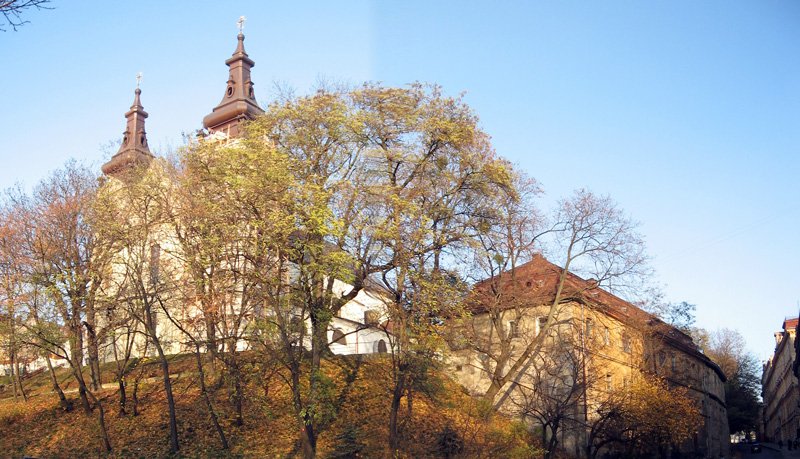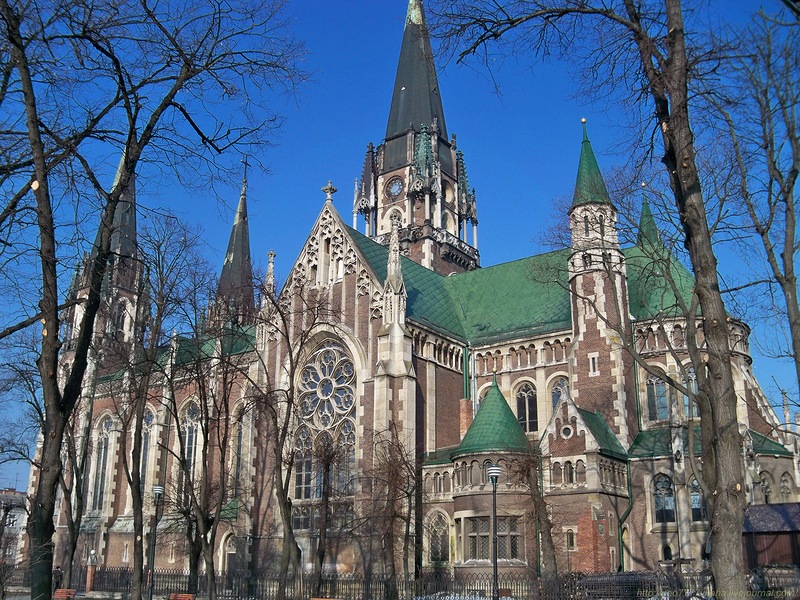By Agha Iqrar Haroon
This is IV part of my Tourism Guide of Lviv Ukraine and II part of my travelogue of Churches and Cathedrals of Lviv. In first part of travelogue of churches and cathedrals, I provided information about Armenian Church, Dominican Church (Dominican Cathedral), Bernardine Monastery and St. Andrew Church and St. George’s Cathedral.
First piece about churches and cathedrals can be read to click this link.
Now I will guide my readers to some of additional but historic churches and cathedrals of Lviv in this second part of “In Search of Faith—Churches and Cathedrals in Lviv”
I will carry my readers to Saints Peter and Paul Garrison Church, St. Mary Magdalene Church, Carmelite Convent and Church of Saints Olha and Elizabeth. There are several more churches and cathedrals in Lviv and my readers can do their own research if they have special interest in religious places as I do have.
One important point I wish to mention here for photographers. Almost there is no historic building in Lviv you can capture in your camera by avoiding overhead cables of Electric Bus (Tramp). Photographers cannot avoid such overhead cables because you need to have long shot or mid shot for best quality frames but Electric Bus cables come between your camera and the building. Same problem I encountered at many places in Zurich years ago.
Should we start our second journey to Churches and Cathedrals? —- Yes follow me please:


Saints Peter and Paul Garrison Church
Saints Peter and Paul Garrison Church is also known as the Jesuit Church so please follow your map instead of asking people. Best option to travel in Lviv is following Google Maps. Church is at Teatralna Street. Construction of Church of the Holy Apostles Peter and Paul began in 1610 and was completed in 1630. The Church is dedicated to Saints Peter and Paul.
When constructed, it was one of the largest churches in the Polish-Lithuanian Commonwealth. Design was drafted by Sebastian Lachmius who followed parametres from Il Gesu in Rome. His designs were modified by a professional Italian architect, Jacopo Briano. An addition to the original design was the 80-meter clock-tower on the South side which used to be the tallest building in Galicia. The upper part of this early 18th-century tower was demolished in 1830.
St. Mary Magdalene Church
The Roman Catholic church of St. Mary Magdalene is located West of the Old Town.
It was built at the beginning of the 17th century for the Dominican Order, combining the styles of Renaissance and Baroque, and consecrated in 1630. According to historians, the church and monastery were plundered and burned in 1704 by Swedes only to be rebuilt by 1758 with an extended nave and new Baroque facade with two towers decorated with pilasters and cornices and decorative sculptures of Saint Dominic and Saint Hyacinth between the pediment and the tower added to the preserved polygonal apse with an altarpiece in stucco presenting scenes from the life of Saint Mary Magdalene.

After the suppression of the Dominican monastery by the Austrian emperor Joseph II in 1783, building was used as a prison and the church was transferred to the diocese. The church underwent some minor changes with the groundwork carried out in front of it in 1880 necessitating the addition of stairs and balcony added above. In 1889, Neo-Baroque tower-helmets were installed along with a clock on the Southern tower.
In 1923, the monastery building was given to the Lviv Polytechnic and in 1927 conservation work was carried out in the complex which continued until the outbreak of World War II.
Under Soviet rule, the church remained open longer than most others in Lviv until it was closed in 1962. Most of the interior was plundered or destroyed, including the side altars, sculptures and ambo, only the organ and altar have survived today. In 1969 the church building was assigned to the Lviv Philharmony which established an organ concert hall in it.
Carmelite Convent

The Carmelite Convent was established in Lviv by Jakub Sobieski. Jakub Sobieski was born on May 5, 1590 and was a Polish noble, parliamentarian, political activist, military leader and father of King John III Sobieski.
Many particulars of design of Carmelite Convent were patterned after the Roman church of Santa Susanna.
Carmelite Church was first mentioned in 1634 as the church of the monastery of the Barefoot Carmelites. The suburban location caused the church to be rather well fortified, yet it was ravaged by the Cossacks in the Khmelnytsky Revolt and the Swedes in the Great Northern War. The entire façade was redesigned in the 19th century.
Still, the building retains much of its original character and design, attributed to architect Jan Pokorowicz. Especially noteworthy are the 300-year-old black marble altar and a series of frescoes executed by Giuseppe Pedretti in the 1730s.
The Carmelites departed from the monastery in 1792 and it was later used as a metrology office.
After 1789 the church has passed through a succession of owners, ending with the Ukrainian Greek Catholic Church which reconsecrated the church to Michael the Archangel in 1991.
Latin Cathedral

The Archcathedral Basilica of the Assumption of the Blessed Virgin Mary is usually called as the Latin Cathedral.
It was constructed in 14th-century and is situated in Old Town of Lviv South Western corner of the market square. This part of market is called Cathedral Square.
The first church built on this site was a small wooden Roman Catholic church dedicated to the Holy Trinity which was built in 1344 but burnt down in a fire after six years of its construction. In 1360, the king Casimir III of Poland founded the construction of the present day church, built in Gothic style. Construction work continued throughout the 15th century and in 1481 the Cathedral was finally consecrated.
The cathedral witnessed many significant events and was visited by several Polish kings. In the years 1761–1776 the Cathedral was refurbished in the Baroque style and a tall bell tower was added. In 1776 the wonder working icon of the Mother of God held in the Cathedral was crowned and placed in the main altar. In 1892–1898 the presbytery was remodeled in the Neogothic style and stained glass, designed by Józef Mehoffer and Jan Matejko were installed. In 1910 the Cathedral was granted the status of a minor basilica by Pope Pius X.
The Latin Cathedral is one of the just two churches in Lviv that weren’t closed or subjected to the Muscovite Patriarchate during Soviet rule (the other being the Roman Catholic church of St. Anthony in Lychakiv), however during that time the bishops resided in Lubaczów, a town in southeastern Poland, close to the border with Ukraine.
Church of Saints Olha and Elizabeth

The Church of Saints Olha and Elizabeth is situated between the main Railway station and the Old Town of Lviv. It was originally built as the Roman Catholic Church of St. Elizabeth and today serves as the Greek Catholic Church of Saints Olha and Elizabeth.
The church was built by the Latin Archbishop of Lviv Saint Joseph Bilczewski in the years 1903-1911. It was designed by Polish architect Teodor Talowski in the neo-Gothic style, similar to that of the Votive Church in Vienna. If you are arriving to Lviv by train, this Church is first important building you will before you come out of train through window of your train wagon.
In 1939, the church was damaged in a bombing raid but remained open until 1946. After the war, the building was used as warehouse and fell further into ruin, until it was returned to faithful with the collapse of the Soviet Union. In 1991 a Ukrainian Greek Catholic was established and the church was re-consecrated as the Greek Catholic church of Saints Olha and Elizabeth.
Travel for Cause—Lviv Tourism Guide Part I
Travel for Cause: Lviv Tourism Guide Part II—Tustan Fortress—A Wooden structure on Rocks
Travel for Cause: Lviv Tourism Guide Part II—Tustan Fortress—A Wooden structure on Rocks
Travel for Cause: Tourism Guide of Lviv Part III — In Search of Faith — Churches and Cathedrals in Lviv
Travel for Cause: Tourism Guide of Lviv Part IV — In Search of Faith — Churches and Cathedrals in Lviv
My journey to Lviv is yet not over. Stay with me and I will take you to more interesting places before we will depart to another amazing city of Ukraine— Guess where we would go?

